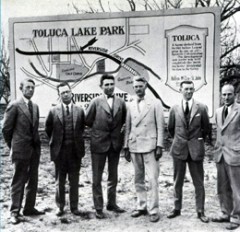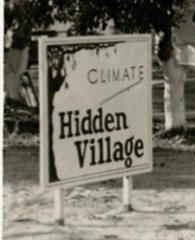by Richard Bogy

Beginning in 1922, as construction of Lakeside Golf Club of Hollywood moved forward, a group of land investors began to buy the farms to the north of the Club. They had an idea to build what would become the first “bedroom” community for Los Angeles in the San Fernando Valley. Initially the project was to be called Toluca Lake Park. By 1923 the project was stalled. Investors from nearby Hollywood joined the project and formed The Toluca Lake Company. With new capital and fresh ideas the project moved forward. The community name was shortened to Toluca Lake, and a community plan was created that included an architectural vision and four distinct areas within Toluca Lake. Throughout the Toluca Lake community signs were installed that featured the Toluca Lake Company logo; a swan over rippled water. Some of those original community signs remained as late as the 1970’s.
The new plan envisioned four communities within Toluca Lake that would each have a different style and “feel.” The area bordered by Clybourn, Riverside Drive, Forman Avenue and Valley Spring Lane would be called “Toluca Lake Village” or just “The Village.”  It would feature a traditional suburban style, with sidewalks, street curbs, street lamps and home lots that averaged 6000 to 7000 square feet. The streets would curve and meander to the natural flow of the land.
It would feature a traditional suburban style, with sidewalks, street curbs, street lamps and home lots that averaged 6000 to 7000 square feet. The streets would curve and meander to the natural flow of the land.
The second area would be called “Spring Valley,” and it would be bordered by Forman Avenue, Valley Spring Lane, Ledge Avenue and Moorpark Street. That area would feature large estates, with land sold in roughly one acre parcels and multiple parcels welcomed. It was anticipated that many of Spring Valley homes would keep horses to ride along the nearby Los Angeles River. Up until the 1950’s there were still horses in Spring Valley. A reminder of those days can still be found with the “No horses on sidewalk” sign on Toluca Lake Avenue. The “Spring Valley” moniker was dropped in the 1930’s when the area lived up to its name. During heavy rains the natural riverbeds along Whipple and Woodbridge would fill with water, encourage by the gurgling springs that bubbled up from the ground. Spring Valley would fill with water and form a seasonal pond.

The third Toluca Lake was called “Hidden Village” and it was bordered by Riverside Drive, Cahuenga Boulevard, Camarillo Street and Forman Avenue. Hidden Village would feature “country estate lots,” with no sidewalks, no curbs, wider streets and no street lights. The average lot would be 11,000 square feet, except for those parcels between Ledge and Cahuenga, which would be larger and sized at an average one acre.

Hidden Village was previously a walnut grove and the residential lots were cut into the grove, preserving many of the original walnut trees (a few of which remain today) and enhancing the “country feel.”
The last Toluca Lake was called “Toluca Woods,” and it would be built on the land between Camarillo, Clark (the Burbank boundary), Cahuenga and Clybourn. The plan for Toluca Woods was to have a similar country feel to Hidden Village, but with smaller lots and “more affordable” houses. Toluca Woods remained greatly undeveloped until after the Second World War, when developer Fritz Burns – with the financial backing of industrialist Henry Kaiser – began building houses for the returning veterans.
In each of the four communities identifying signs were installed which included a different single word reason to choose Toluca Lake as your new home.

As a side note, the original Toluca Lake plan called for houses to be built in the Spanish style. The plan was to create a Spanish village that would complement the nearby historic Campo de Cahuenga. As lots were sold the buyer was asked to agree to that style, until Bette Davis bought her lot. After agreeing to a Spanish style home Bette decided to build an English country home. After that time the Spanish style was no longer a condition of purchase.
